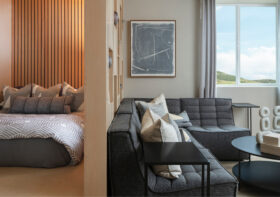The Show Starts on the Sidewalk
In 1922, the dawn of the Golden Age of film, a young architect came to Los Angeles and won the assignment for the Tower Theater on Broadway, the first of S. Charles Lee’s more than 400 theaters and movie palaces throughout California and Mexico. His designs took you to Louis XIV’s Versailles or Spain’s Alhambra, and inspired theater design all over America. His famous quote, “The Show Starts on the Sidewalk” has become an inspiration for me, to create an immersive environment, capture the imagination, tell a story, and create a distinguishing identity that separates my work from others. To achieve such lofty goals, there are several layers of ingredients that are part of the process, including research and authenticity, understanding of proportion and emphasis, color theory and landscape.
An internet search for “Curb Appeal” listed numerous references to television shows on the topic, with before and after photos that highlighted some of these points. Two main characteristics were remodels emphasizing enhanced entries and a bolder or more calculated use of color.
For new projects, I often begin by reviewing historic precedents, looking for style cues that may be adaptable to contemporary floor plans. This may come in the form of photo storyboards to consider one architectural language against another or to understand distinguishing or character-defining elements. While traditional styles have certain precedents that can be followed, contemporary designs, because there is a wide range of what that can mean, have other challenges. What can be achieved often comes down to understanding specific materials and detail renditions. In our designs, we strive for authenticity for specific character-defining elements, then interpret these items for “new” elements like garage facades.
To catch the eye, we need to ensure that the building proportions and organization is composed of a series of focal points, as an artist composes his work, with the dominant one being the front door/entry sequence. At times, the front door may be on the side of the house or hidden within a courtyard, more challenging in that the curb appeal must direct us to the front door! At times, in addition to the entry, a bold secondary emphasis such as a picture window, and then other lesser detail elements complete the composition. Without such rigorous design, awkward design elements such as homes with over-scaled or under-scaled columns for the particular style or tiny shutters for a large picture window, can throw the whole composition off.
Color is an important part of curb appeal. This is where an expert can make a big difference. Donna Aldrich, Principal of our in-house Color Studio, adds several important considerations, noting the Color Marketing Group’s slogan “Color Sells, But the Right Color Sells Better”! The careful use of colors and materials can further define the architectural style and bolder colors can create something memorable. She also notes that when the architecture is good (authentic, well-proportioned, with interesting mass compositions, shadow breaks, etc.) that colors become less critical. On a recent trip to visit new master planned communities in northern California, I was surprised by the often awkward color schemes that in my eyes, diminished the quality of the developments. Colors and materials can be very personal and may have regional or cultural influences as well, nevertheless, I noticed in my internet search, often the “before” photos made me think of a woman without makeup and that through the strategic use of color and small added details like shutters, the homes would seem to come to life.
Increasingly, our quest for enhanced curb appeal really does begin at the sidewalk. As lots become smaller, an overall theme to new homes is that the home extends to the perimeter of the lot requiring a more thoughtful use of outdoor spaces and landscaping. Front yards have been disappearing but what remains is an important setting for the individual home. Often the driveway becomes one of the largest components of the front yard so it must be treated with material texture and color. The approach to the front door will feature enhanced paving and accoutrements such as low walls, planters, lighting, pottery and address signage that reinforce the theme of the home. Some styles such as Spanish may afford the use of walled courtyards to expand the liveability of the home into the front yard.
S. Charles Lee knew something about creating an immersive environment. Incorporating a strategy based on research, authenticity, strong use of color, and encompassing thoughtful landscape design, your architecture will start its show on the sidewalk too.
This article has also been published in the latest issue of Builder and Developer magazine.





3d renderings architectural design
It’s useful for all, Thanks for sharing this post, I read this article it’s very helped us and I am impressed with your site’s blog. You have amazing site thanks for giving us such nice information